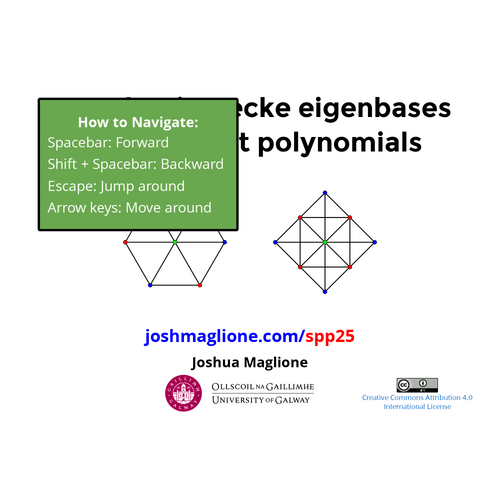Computing order zeta functions via resolution of singularities
Joshua Maglione
Universität Bielefeld
jmaglione@math.uni-bielefeld.de
Reporting on work in progress with ...



Universität Bielefeld
Universität Oldenburg
Universität Oldenburg
Enumerating subgroups of \(\mathbb{Z}^d\)
For \(d=1\), exactly one subgroup of index \(n\), for all \(n \geq 1\).
Record this in a Dirichlet generating function:
For the general case, it is slightly more complicated.
Challenging to explicitly compute for general groups, but \(\mathbb{Z}^d\) is easy.
What about subrings of \(\mathbb{Z}^d\)?
All our subrings are unital. Nontrivial examples occur when \(d \geq 3\).
The \(d = 3\) case follows from Datskovsky–Wright (1986).
Subring zeta function satisfies an Euler product decomposition:
The zeta functions \(\zeta_{R, p}(s)\) are called local zeta functions.
Nakagawa (1996) and Liu (2007) prove that \(\zeta_{\mathbb{Z}_p^4}(s)\) is
The \(d \geq 5\) case is open.
Notice some properties of the local subring zeta functions:
- Rational function in both \(p\) and \(p^{-s}\)
\(\Longrightarrow\) exists recurrence relation among \(a_n(\mathbb{Z}^d)\)
- Palindromic numerators
\(\Longrightarrow\) suggests restrictive geometric structure
- Uniform for all primes \(p\)
\(\Longrightarrow\) suggests nice structure of underlying varieties
The general setting
Fix a number field \(K\) and its ring of integers \(\mathcal{O}_K\).
The order zeta function is
where \(H\) runs over all finite index subrings of \(\mathcal{O}_K\), i.e. suborders.
These order zeta functions give analytic data of a fixed order, \(\mathcal{O}_K\).
Different perspectives consider all sub-orders with other properties.
Order zeta functions have an Euler product decomposition:
where the product runs over all rational primes \(p\) in \(K\).
There are subtleties based on how \(p\) splits in \(K\). We consider the totally split case, so that
The ring \(\mathbb{Z}^d\) has one key advantage:
Instead, count multiplicatively closed sublattices of \(R'\):
That is, enumerate not necessarily unital subrings of \(R'\).
\(p\)-adic cone integrals
We represent \(\zeta_{K,p}^<(s)\) as a \(p\)-adic cone integral. Notation:
For integers \(\ell,m\), a sequence of polynomials in \(\mathbb{Z}[x_1,\dots, x_m]\),
is called cone integral data.
Associate to \(\mathscr{D}\), the closed subset of \(\mathbb{Z}_p^m\):
and the following cone integral:
The order zeta functions are equal to suitable cone integrals.
Ex: A cone integral for the subring zeta function of \(\mathbb{Z}_p^3\) is
where the set \(\mathscr{M}\) contains all \(x\in\mathbb{Z}_p^3\) satisfying
Because the cone data is not (locally) monomial, computing this requires different tools.
Computing cone integrals via resolution of singularities
Theorem. (du Sautoy, Grunewald 2000)
Let \(L\) be a ring. There are smooth algebraic varieties \(V_t\), \(t\in\{1,\dots, m\}\), defined over \(\mathbb{Q}\), and rational functions \(W_t(X, Y)\in \mathbb{Q}(X, Y)\), such that for almost all primes \(p\),
where \(c_t(p)\) denotes the number of \(\mathbb{F}_p\)-rational points of \(\overline{V}_t\), the reduction of \(V_t\) modulo \(p\).
From cone data \(\mathscr{D} = (f_0, g_0;\, \dots,\, f_\ell, g_\ell)\), we apply resolution of singularities to monomialize every \(f_i\) and \(g_i\).
Want an explicit resolution of the ideal generated by
Challenges:
- Number of variables for \(\mathbb{Z}_p^d\) case is \(\binom{d}{2}\).
- Little to no useful features of \(F_d(x)\) in general.
A (sideways) tree of blowing up:
not locally monomial
locally monomial
Du Sautoy–Grunewald give blueprint to compute cone integrals by:
(1) applying a resolution of singularities and
(2) counting \(\mathbb{F}_p\)-rational points on varieties.
Apply ideas of Bierstone–Milman (2006) and Blanco (2012a, 2012b) to monomialize binomials.
We need only monomialize \(\mathscr{D}\). Gives a little more freedom.
Solving monomial integrals
Once \(\mathscr{D}\) is monomial, translate \(p\)-adic integral to counting integral points on rational polyhedron \(\mathcal{P}\subseteq \mathbb{R}^r\).
Theorem. (Barvinok (1994))
There exists an algorithm that, given a rational polyhedron \(\mathcal{P}\) of a fixed dimension \(r\in\mathbb{N}\), returns the generating function in poly-time
Barvinok's algorithm has implementations in Sage via LattE.
We use Rossmann's Zeta package to compute monomial integrals, which also employs LattE, Rossmann (2018).
Tree of blowing ups for \(\mathbb{Z}^4\)

We have 74 charts, with 38 leaves and 185 monomial integrals.
We have verified \(\zeta_{\mathbb{Z}_p^4}(s)\) with our methods.
From the du Sautoy, Grunewald theorem before,
where the \(c_t(p)\) enumerated the \(\mathbb{F}_p\)-rational points of \(\overline{V}_t\).
The Nakagawa, Liu formula for \(\zeta_{\mathbb{Z}_p^4}(s)\) holds for all primes \(p\).
The varieties \(V_t\) in our computation had "tame" structure.
- For exactly 2 varieties, \(c_t(p)\) depended on parity of \(p\).
- Of the 185 varieties, computed \(c_t(p)\) by hand for 13 of them.
- For every variety, \(c_t(p)\) is given as a polynomial in \(p\) or 2 polynomials depending on if \(p = 2\) or not.
An overview of the algorithm:
(1) Locally monomialize the cone data \(\mathscr{D}\),
(2) Monomialize by counting \(\mathbb{F}_p\)-rational points on varieties,
(3) Apply Barvinok's algorithm to evaluate monomial \(p\)-adic integrals.
Still in a prototypical stage and shows promise:
- for extending computations of \(\zeta_{\mathbb{Z}^d}(s)\) and to other rings like \(\mathbb{Z}[x]/(x^d)\),
- for bringing computational tools from algebraic geometry to solve \(p\)-adic integrals.
Thank you
Computing order zeta functions via resolution of singularities
By Josh Maglione
Computing order zeta functions via resolution of singularities
For a number field K with ring of integers O, the order zeta function of K is a Dirichlet generating series enumerating orders, i.e. unital subrings of O of finite index. In comparison with the Dedekind zeta function of K, the order zeta function of K is poorly understood: for number fields of degree larger than 5, next to nothing general is known. Encoding this Dirichlet series as a p-adic integral, we develop computational tools to repeatedly resolve singularities until it is distilled to enumerating points on polyhedra and p-rational points of algebraic varieties. This is joint work with Anne Fruehbis-Krueger, Bernd Schober, and Christopher Voll.
- 1,753




